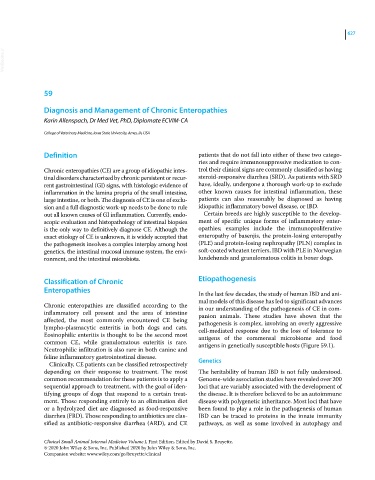Page 659 - Clinical Small Animal Internal Medicine
P. 659
627
VetBooks.ir
59
Diagnosis and Management of Chronic Enteropathies
Karin Allenspach, Dr Med Vet, PhD, Diplomate ECVIM-CA
College of Veterinary Medicine, Iowa State University, Ames, IA, USA
Definition patients that do not fall into either of these two catego-
ries and require immunosuppressive medication to con-
Chronic enteropathies (CE) are a group of idiopathic intes- trol their clinical signs are commonly classified as having
tinal disorders characterized by chronic persistent or recur- steroid‐responsive diarrhea (SRD). As patients with SRD
rent gastrointestinal (GI) signs, with histologic evidence of have, ideally, undergone a thorough work‐up to exclude
inflammation in the lamina propria of the small intestine, other known causes for intestinal inflammation, these
large intestine, or both. The diagnosis of CE is one of exclu- patients can also reasonably be diagnosed as having
sion and a full diagnostic work‐up needs to be done to rule idiopathic inflammatory bowel disease, or IBD.
out all known causes of GI inflammation. Currently, endo- Certain breeds are highly susceptible to the develop-
scopic evaluation and histopathology of intestinal biopsies ment of specific unique forms of inflammatory enter-
is the only way to definitively diagnose CE. Although the opathies; examples include the immunoproliferative
exact etiology of CE is unknown, it is widely accepted that enteropathy of basenjis, the protein‐losing enteropathy
the pathogenesis involves a complex interplay among host (PLE) and protein‐losing nephropathy (PLN) complex in
genetics, the intestinal mucosal immune system, the envi- soft‐coated wheaten terriers, IBD with PLE in Norwegian
ronment, and the intestinal microbiota. lundehunds and granulomatous colitis in boxer dogs.
Classification of Chronic Etiopathogenesis
Enteropathies
In the last few decades, the study of human IBD and ani-
mal models of this disease has led to significant advances
Chronic enteropathies are classified according to the in our understanding of the pathogenesis of CE in com-
inflammatory cell present and the area of intestine panion animals. These studies have shown that the
affected, the most commonly encountered CE being pathogenesis is complex, involving an overly aggressive
lympho‐plasmacytic enteritis in both dogs and cats. cell‐mediated response due to the loss of tolerance to
Eosinophilic enteritis is thought to be the second most antigens of the commensal microbiome and food
common CE, while granulomatous enteritis is rare. antigens in genetically susceptible hosts (Figure 59.1).
Neutrophilic infiltration is also rare in both canine and
feline inflammatory gastrointestinal disease.
Clinically, CE patients can be classified retrospectively Genetics
depending on their response to treatment. The most The heritability of human IBD is not fully understood.
common recommendation for these patients is to apply a Genome‐wide association studies have revealed over 200
sequential approach to treatment, with the goal of iden- loci that are variably associated with the development of
tifying groups of dogs that respond to a certain treat- the disease. It is therefore believed to be an autoimmune
ment. Those responding entirely to an elimination diet disease with polygenetic inheritance. Most loci that have
or a hydrolyzed diet are diagnosed as food‐responsive been found to play a role in the pathogenesis of human
diarrhea (FRD). Those responding to antibiotics are clas- IBD can be traced to proteins in the innate immunity
sified as antibiotic‐responsive diarrhea (ARD), and CE pathways, as well as some involved in autophagy and
Clinical Small Animal Internal Medicine Volume I, First Edition. Edited by David S. Bruyette.
© 2020 John Wiley & Sons, Inc. Published 2020 by John Wiley & Sons, Inc.
Companion website: www.wiley.com/go/bruyette/clinical

